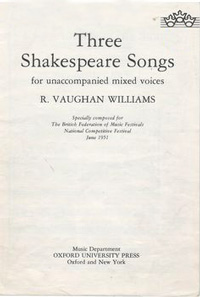
Ralph Vaughan Williams was an English composer. His works include operas, ballets, chamber music, secular and religious vocal pieces and orchestral compositions including nine symphonies, written over sixty years. Strongly influenced by Tudor music and English folk-song, his output marked a decisive break in British music from its German-dominated style of the 19th century.

Prospero is a fictional character and the protagonist of William Shakespeare's play The Tempest. Prospero is the rightful Duke of Milan, whose usurping brother, Antonio, had put him to sea on a "rotten carcass" of a boat to die, twelve years before the play begins. Prospero and Miranda had survived and found exile on a small island. He has learned sorcery from books, and uses it while on the island to protect Miranda and control the other characters.
Caliban, son of the witch Sycorax, is an important character in William Shakespeare's play The Tempest.

A Sea Symphony is an hour-long work for soprano, baritone, chorus and large orchestra written by Ralph Vaughan Williams between 1903 and 1909. The first and longest of his nine symphonies, it was first performed at the Leeds Festival in 1910 with the composer conducting, and its maturity belies the relatively young age – 30 – when he began sketching it. Moreover it is one of the first symphonies in which a chorus is used throughout as an integral part of the texture and it helped set the stage for a new era of symphonic and choral music in Britain during the first half of the 20th century. It was never numbered.
Sinfonia antartica is the Italian title given by Ralph Vaughan Williams to his seventh symphony, first performed in 1953. It drew on incidental music the composer had written for the 1948 film Scott of the Antarctic.
"Ariel's song" is a verse passage in Scene ii of Act I of William Shakespeare's The Tempest. It consists of two stanzas to be delivered by the spirit Ariel, in the hearing of Ferdinand. In performance it is sometimes sung and sometimes spoken. There is an extant musical setting of the second stanza by Shakespeare's contemporary Robert Johnson, which may have been used in the original production around 1611.
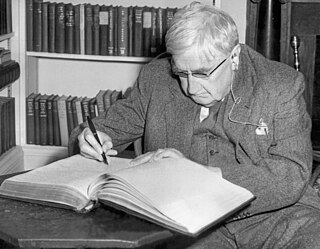
The Symphony No. 9 in E minor was the last symphony written by the English composer Ralph Vaughan Williams. He composed it during 1956 and 1957, and it was given its premiere performance in London by the Royal Philharmonic Orchestra conducted by Sir Malcolm Sargent on 2 April 1958, in the composer's eighty-sixth year. The work was received respectfully but, at first, without great enthusiasm. Its reputation has subsequently grown, and the symphony has entered the repertoire, in the concert hall and on record, with the majority of recordings from the 1990s and the 21st century.

The Tempest incidental music, Op. 1, is a set of movements for Shakespeare's play composed by Arthur Sullivan in 1861 and expanded in 1862. This was Sullivan's first major composition, and its success quickly brought him to the attention of the musical establishment in England.
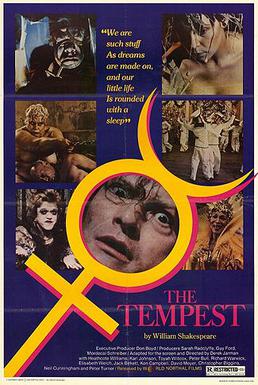
The Tempest is a 1979 film adaptation of William Shakespeare's play of the same name. Directed by Derek Jarman, produced by Don Boyd, with Heathcote Williams as Prospero, it also stars Toyah Willcox, Jack Birkett, Karl Johnson and Helen Wellington-Lloyd from Jarman's previous feature, Jubilee (1977).
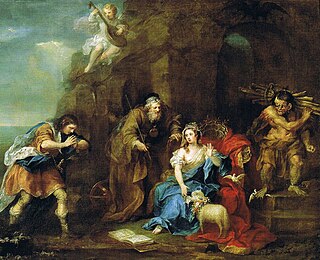
Scene from Shakespeare's The Tempest, also known as Ferdinand courting Miranda is an oil painting by the English painter William Hogarth. It has been displayed at Nostell Priory since 1766, and was acquired by the National Trust in 2002. The National Trust claims that it is "the first known painting of a scene from Shakespeare".

Voyage to Melonia is a 1989 Swedish-Norwegian animated adventure fantasy film directed by Per Åhlin, loosely based on William Shakespeare's The Tempest, with further inspiration from Jules Verne's Propeller Island and Charles Dickens' Oliver Twist. It was Åhlin's first fully animated feature film, as his earlier films Out of an Old Man's Head and Dunderklumpen! had both used a mix of animation and live action.
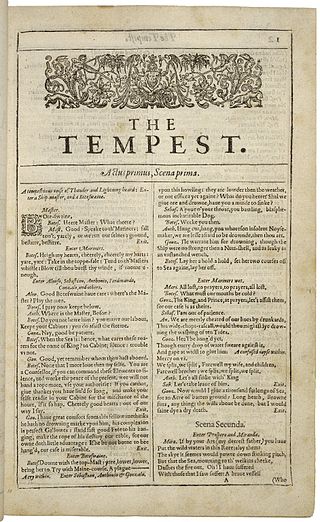
The Tempest is a play by William Shakespeare, probably written in 1610–1611, and thought to be one of the last plays that he wrote alone. After the first scene, which takes place on a ship at sea during a tempest, the rest of the story is set on a remote island, where Prospero, a complex and contradictory character, lives with his daughter Miranda, and his two servants: Caliban, a savage monster figure, and Ariel, an airy spirit. The play contains music and songs that evoke the spirit of enchantment on the island. It explores many themes, including magic, betrayal, revenge, and family. In Act IV, a wedding masque serves as a play-within-a-play, and contributes spectacle, allegory, and elevated language.
Roderick Gregory Coleman Williams OBE is a British baritone and composer.
The Norfolk Rhapsodies are three orchestral rhapsodies by Ralph Vaughan Williams, drafted in 1905–06. They were based on folk songs Vaughan Williams had collected in the English county of Norfolk, in particular the fishing port of King's Lynn in January 1905. Only the first rhapsody survives in its entirety, having been revised by the composer in 1914. The second exists in fragmentary form, and has been completed by other hands. The third is lost.

The Tempest is an Australian television play, an adaptation of the play by William Shakespeare. Directed by Alan Burke, it stars Reg Livermore. The play aired on 16 October 1963 in Sydney.
Music in the plays of William Shakespeare includes both music incidental to the plot, as song and dance, and also additional supplied both by Shakespeare's own company and subsequent performers. This music is distinct from musical settings of Shakespeare's sonnets by later composers.

A Midsummer Night's Dream is a 55-minute studio album containing the overture and almost all of the incidental music that Felix Mendelssohn wrote to accompany William Shakespeare's play of the same name. It is performed by Kathleen Battle, Frederica von Stade, the Tanglewood Festival Chorus and the Boston Symphony Orchestra under the direction of Seiji Ozawa, with interlinking passages of verse spoken by Judi Dench. It was released in 1994.

The Tempest is a 1908 British-made silent film directed by film pioneer Percy Stow who specialised in trick photography.

Folk Songs of the Four Seasons is a cantata for women's voices with orchestra or piano by English composer Ralph Vaughan Williams written in 1949. Based on English folk songs, some of which he had collected himself in the early 20th century, the work was commissioned by the Women's Institute for a Singing Festival held at the Royal Albert Hall on 15 June 1950. The first performance featured a choir of 3,000 women, accompanied by the London Symphony Orchestra conducted by Sir Adrian Boult. Ursula Vaughan Williams remembered that owing to the huge choir "the audience seemed far fewer than the performers".
